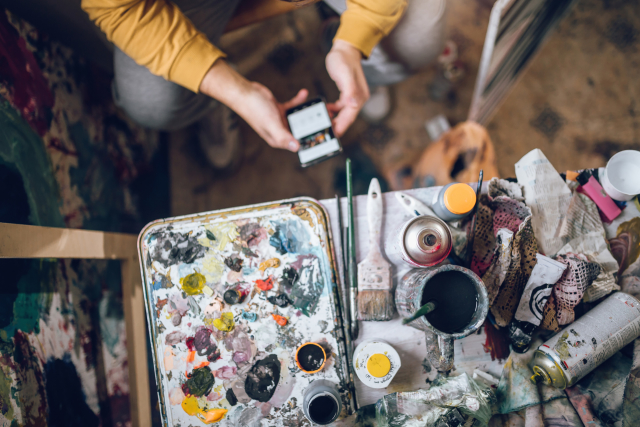How are artists to sell works at a time when art fairs are being canceled and galleries are often empty? This question, which is mainly posed in regard to the COVID-19 pandemic, is forcing the pace of innovation in the art market. In a bid to sell their works, many artists have turned to social networks to enter into contact with collectors, who are increasingly likely to buy art online.
According to a recent survey by Swiss bank UBS and the organizers of Art Basel, a majority of art collectors or 59%, report that the health crisis has increased their interest in collecting. This trend was even more pronounced among millennials, who are less likely than their elders to balk at the idea of spending large sums online.
Encouraged by this development, many artists are now seeking to promote and sell their works on social networks, particularly on Instagram.
A notable case in point is the British artist Matthew Burrows, who, in March this year, launched the #ArtistSupportPledge initiative to encourage his peers to participate in a collaborative ecosystem.
The idea of Burrows’ initiative is quite simple. Artists post images of works they are willing to sell for no more than 200 pounds (around $255 dollars or approx. P12,300)) on Instagram. If or when they make 1000 pounds (about $1,200 or around P62,600) in sales via the scheme, they commit to buying a work by another participating artist.
https://www.instagram.com/p/CFAdR-olvBN/?utm_source=ig_embed
This virtuous circle has proven to be very successful, according to Burrows, who told The Art Newspaper that the initiative had generated close to 60 million pounds (around $77 million or P4.1 billion), with online sales of 371,000 works.
Is Instagram a hothouse for emerging artists?
While some artists are currently turning to social networks in response to the health crisis, others are already well-established on Instagram where they have a loyal following of customers.
British painter Sophie Tea claimed in 2019 to have earned a million pounds (around $1.2 million or P62.6 million with a series of colored nudes sold exclusively on Instagram.
The same is true of Australian artist CJ Hendry, whose ultra-realist drawings are viewed by 524,000 followers including Kanye West. The American rapper himself reportedly bought a drawing in which his face appears on a 100-dollar bill for an undisclosed sum.
https://www.instagram.com/p/CCPvXLPDScY/?utm_source=ig_embed
“In the past, artists had to wait for a gallery to do your show and people could not just see your work. They had to come to the exhibition when the gallery allowed it to happen. Now, you can show people whatever you want at any time you wish,” explained Hendry to CNN.
Galleries and auction houses counterattack
In response to the boom in online art sales, galleries and auction houses are taking steps to reach out to collectors on the internet.
According to a recent Artnet News study, Christie’s, Sotheby’s and Phillips have organized more than 130 online auctions in the last six months, twice as many as they did in the same period last year. Thus far, these have generated sales of 190 million dollars (approx. P9.2 billion).
“There were more collectors who bid this season without seeing the work in person who had said they would never do that than I would have ever expected,” pounted out David Galperin, a Sotheby’s contemporary art specialist.
A similar surge in internet revenues has been reported by art galleries like Gagosian, David Zwirner and Hauser & Wirth, which have succeeded in organizing six-figure sales online in spite of the pandemic.
When the Jeff Koons sculpture, “Balloon Venus Lespugue (Red)”, was snapped up for the sum of $8 million (about P388 million) last June, it became the most expensive work ever to be sold online by the David Zwirner gallery.
It is safe to assume that with record prices like these, galleries and auction houses will remain keen to develop their presence and revenues on the internet. CC
RELATED STORIES:
Rebooting the art scene: ‘Worst times can make the best of art’
Beep beep! Museums hold drive-thru exhibitions amid the coronavirus pandemic



